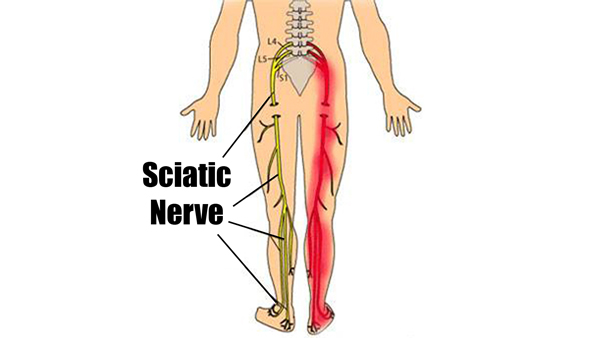
Sciatica is a term used to describe any type of pain, numbness, electric pain, muscle weakness, or discomfort that radiates from the lower back, hip and/or buttocks down into one or both legs.
It gets this name after the sciatic nerve which begins in the lower back and travels all the way down into the feet. When the sciatic nerve gets pinched, pain radiates from the point of impingement downward. If severe enough, the pinched nerve can affect both legs at the same time.
Causes of a Pinched Sciatic nerve
Sciatica can be caused from a lumbar disc herniation usually L4/L5 or L5/S1, putting direct pressure on the nerve roots (hence the name pinched nerve), leading to inflammation and radiating pain in the leg.
Sciatica can also be caused from Degenerative Disc Disease, where the disc has become dehydrated and thinned over time, leading to a direct compression of the sciatic nerve roots again causing inflammation and leg pain.
Piriformis Syndrome
But, perhaps the most common cause of sciatica is due to the nerve’s position in relation to the Piriformis muscle. The Piriformis muscle attaches from the lateral side of the sacrum to the greater trochanters of the femurs. It causes external rotation of the hip joint.
The sciatic nerve passes either under, through or on top of the piriformis muscle depending on the individual. Therefore certain people are more prone to having sciatic leg pain than others.
When the Piriformis muscle becomes tight and constrictive, it puts direct pressure around the sciatic nerve leading to inflammation and radiating leg pain. This condition is aptly called Piriformis Syndrome.
Treating Sciatica Caused by Piriformis Syndrome
- Improve Posture: depending on the position of your sciatic nerve, if you improve your posture to an anatomically neutral position while sitting, standing and walking you can prevent Piriformis Syndrome from developing and/or returning. Some coaching by a qualified chiropractor is necessary to effectively improve one’s posture.
- Massage: massaging the piriformis muscle, lumbar erectors, and hamstrings help decrease muscle tension around the sciatic nerve and reduce leg pain.
- Stretching: stretching should be a part of your daily routine. Stretches that lengthen the piriformis and gluteal muscles have great effect on reducing the muscle tension in those muscles. With reduced muscles tension around the sciatic nerve, the less chance of irritation.
- Avoid Sitting Too Long In One Position: one of the biggest factors in Piriformis Syndrome is the causative agent of staying immobile for too many minutes per day in hip flexion. Sitting causes a lengthening of the piriformis and when you stand, the muscle responds by over-contracting, leading to leg pain from a compressed sciatic nerve.
- Practice Relaxing: maintaining a relaxed skeletal demeanor can prevent certain muscles like your Piriformis from becoming over active whereas as a stressed out spine can lead to tight muscles causing radiating leg pain. If possible, you should put aside 10-15 minutes each day to simply tune out all the noise around you and just be.
Treating Sciatica Caused by a Lumbar Herniated Disc
- Chiropractic Spinal Adjustments: if your leg pain is caused by a misaligned lumbar vertebra, then low back spinal adjustments by a trained chiropractor can instantly remove pressure on the sciatic nerve. Chiropractic adjustments have been proven to effectively reduce local inflammation and keeping the joints in the low back moving within functional ranges of motion. Since muscles tend to cause pain due to subtle variations in joint positions, Chiropractic adjustments will reduce this pain and help restore normal muscular and joint function once the vertebrae are realigned.
- Spinal Decompression Therapy: non-surgical spinal decompression therapy has been shown to have a high success rate in helping sciatic nerve pain. The decompression therapy tables provide traction in opposite directions of the injured disc’s vertebrae. This creates a negative pressure inside the disc and the contents of the nucleus pulposus are gently pulled inward, relieving pressure of the sciatic nerve root.
Give it Time
Treatment of sciatic nerve pain can take a few days to a few weeks to resolve depending on how severe your piriformis syndrome is and/or how severe your disc herniation or degeneration is. However, if you stay the course and follow the recommendations set forth by your chiropractor, results are sure to follow.
If you have or think you have sciatica, call 614-428-9310 to schedule your appointment to see if we can help you with your radiating leg pain.